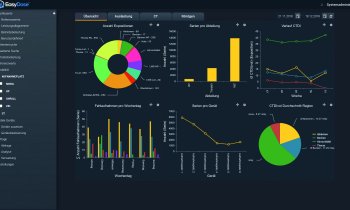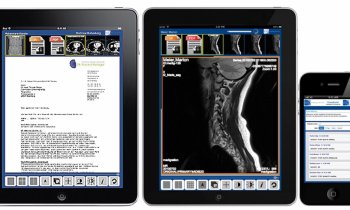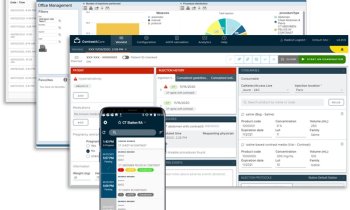PACS and more!
Initiated by Professor Peter Mildenberger and organised by European Hospital, the second PACS and more seminar, held during the DICOM meeting in Mainz, Germany, more than matched its name.
Report: Meike Lerner
Regional and national PACS solutions – the Finnish situation in the healthcare ICT framework was reported on by Jarmo Reponen, Research Manager at FinnTelemedicum and President of the Finnish Society of Telemedicine and eHealth at the University of Oulu, Finland. In Europe, Finland is a forerunner in digitisation and teleradiology: 21 of the country’s hospital districts have worked used PACS since 2007, and about 81% use teleradiology.
The Finish Government decided to set up a national e-archive in 2006; the first phase began at the beginning of the year. This network already provided the best possible prerequisite. However, Jarmo Reponen still saw problems with the national exchange of images: The strict guidelines on data protection currently require a patient’s consent before data can be transmitted.
Peter Gocke, CIO at the University Hospital Eppendorf, discussed the return on investment (ROI) for IT products. It is not always easy to determine this – particularly in the case of complex IT processes, such as the introduction of an electronic patient file (EPR). Calculating digitization advantages – e.g. fast data availability, reduction of redundant entries etc. – must be offset against the initial extra cost, which is difficult to assess. In these cases ROI calculations should not be viewed from a purely static viewpoint but have to be carried out at different points in time.
However, for the acquisition of individual IT components, such as for server virtualisation, the costs are relatively easy to determine by comparison with the costs of maintaining the current status. The rule is that the determination of the ROI only makes sense when the acquisition can be amortised within its expected service life (for IT products about three years).
Josef Brunnhuber, head of IT at the District Hospital Altötting.Burghausen, reported on successful process optimisation due to IT systems used in the hospital’s A&E department. The first step consisted of recording the EMR path, which starts and shows the processes of EMR screening, via diagnosis, to the final treatment report. In this, the complete integration of all IT solutions into the HIS as the control system proved very important. An electronic screening sheet formed the basis of any further proceedings, for example: What priority does the patient have? To which department should he transferred? Does it have the capacity? Once answered, the patient may be transferred to the radiology department where the RIS and PACS utilise existing data from the HIS and, vice versa, the resulting images are then re-fed into the system. The introduction of a dictation workflow was important in this process: The spoken information was recorded using the conventional Dictaphone, but was then tagged as ‘priority’. Language recognition then translates the dictation via the server and transmits it, as a priority, to a typist. Acoustic as well as an optical replay of the translated dictation, which can be corrected immediately, follows. The report is then returned to the originator, consultant or head of department, printed and handed to the patient.
The advantages of a good IT strategy also apply in smaller hospitals and surgeries.
Dennis Feiler, Managing Director of DFC Systems GmbH, Munich/Mannheim, said that insufficient IT structures harbour the danger that legal requirements cannot actually be met, to say nothing of the economic necessities, because an IT outage can bring a company to its knees. Thus he insisted that surgeries and smaller hospitals should think about installing sensible IT structures, even though the implementation may initially appear costly.
A number of functional, legal and technical prerequisites should be met to ensure that investments produce the biggest possible return. He also views server consolidation as the way forward for surgeries: The trend is moving away from singular systems towards a migration to unified servers with a maximum of two to three redundant systems.
Jörg Lemke, Business Development at NetApp, discussed the unified storage potential in ‘cloud computing’. The consolidation of applications and servers into one system raises the questions of how this one system should be built and where located. One alternative to the established silo solution on site would be to outsource the required services. As with other outsourcing, the advantages lie in high flexibility and efficiency. The agreed services are only used as needed and billed on a pay-per-use model. Apart from the elimination of acquisition costs a cloud service brings further financial advantages -- maintenance and security, for example. Additionally, the round-the-clock availability of the system without any downtimes, as well as upgrade options, are part of ROI calculations.
Whilst Stefan Walther, CIO at the University Hospital Düsseldorf, outlined some benefits of IT -- workstation problems solved within an hour, portal systems adapted to processes in about 85% of cases, many different forms already fed into the system, IT teams that train staff to use the hardware and software – he said: ‘New IT components could be possible that allow a configuration with less equipment. The use of new applications would also allow completely new ways of thinking and the use of IT could be increased significantly through a simplification of use that would increase user acceptance. Moreover, IT resources could also be increased considerably under adherence to strict guidelines as new systems allow unconditional configurability.’
07.07.2010











